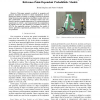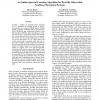35 search results - page 3 / 7 » Learning and Recognizing the Places We Go |
IROS
2008
IEEE
14 years 5 days ago
2008
IEEE
— This paper presents a method to recognize and generate sequential motions for object manipulation such as placing one object on another or rotating it. Motions are learned usin...
IUI
2000
ACM
13 years 10 months ago
2000
ACM
In designing Jabberwocky—a speech-based interface to Microsoft PowerPoint—we have tried to go beyond simple commands like “Next slide, please” and make a tool that aids sp...
WIKIS
2009
ACM
13 years 10 months ago
2009
ACM
Learning “the wiki way”, learning through wikis is a form of selfregulated learning that is independent of formal learning settings and takes place in a community of knowledge...
AAAI
2011
12 years 5 months ago
2011
Recently, a number of researchers have proposed spectral algorithms for learning models of dynamical systems—for example, Hidden Markov Models (HMMs), Partially Observable Marko...
AIRS
2010
Springer
13 years 3 months ago
2010
Springer
Many tasks of information extraction or natural language processing have a property that the data naturally consist of several views--disjoint subsets of features. Specifically, a ...


